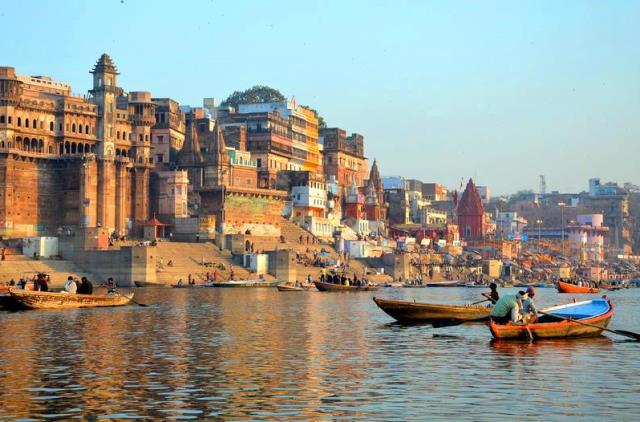THINGS YOU SHOULD EXPERIENCE ONCE IN UTTAR PRADESH
Varanasi Ayodhya Pryagraj
Exploring the Sacred Cities of India: Varanasi, Ayodhya, and Prayagraj
India, a land of rich cultural heritage and profound
spiritual traditions, boasts numerous cities steeped in history and religious
significance. Among these, Varanasi, Ayodhya, and Prayagraj stand out as
quintessential destinations for pilgrims and travelers alike. Each city offers
a unique glimpse into India's spiritual tapestry, blending ancient traditions
with vibrant modern life. Let's embark on a journey to explore the essence of
these sacred cities.
Varanasi: The Eternal City
Historical Significance
Varanasi, also known as Kashi or Benares, is one of
the oldest continuously inhabited cities in the world. Situated on the banks of
the Ganges River, it is a major cultural and religious hub for Hindus. The city
is believed to be the abode of Lord Shiva, and its ghats (riverfront steps) are
renowned for their spiritual ambiance.
Key Attractions
§ Kashi Vishwanath Temple:
Dedicated to Lord Shiva, this temple is one of the twelve Jyotirlingas and a
major pilgrimage site.
§ Dashashwamedh Ghat: Known
for its grand evening aarti (prayer ceremony), this ghat is a sight to behold.
§ Sarnath: Located just
outside Varanasi, Sarnath is where Lord Buddha delivered his first sermon after
attaining enlightenment.
Cultural Experiences
Varanasi is famous for its classical music, dance,
and intricate silk sarees. The bustling markets, vibrant festivals, and
delectable street food add to the city's charm.
Places to
visit:
§
New Vishwanath Temple
§
Kathwala Temple
§ Tulsi Manas Temple
§ Bharat Mata Temple
§
Alamgir Mosque
§
Parshvanath Jain Temple
§
Kalbhairav Temple
§
Dasaswamedh Ghat
§
Assi Ghat
§
Manikarnika Ghat
§
Manmandir Ghat
§
Shivala Ghat
Best
Time: January to March and October to December
Getting there:
§
By Flight – Varanasi is well connected to
major city. Airport situated Approx. 10 to 15 KM from Temple town. You can get
Taxi, cab and Buses to reach Temple.
§
By Train – Train is comfortable and convenient option to reach
Varanasi. You can get train connection from your location.
§
By Road – Bus is one of the most cost-effective options. The town
is well-connected by a network of state and private buses and making it
accessible from various cities in South India.
Ayodhya: The Birthplace of Lord Rama
Historical Significance
Ayodhya, situated on the banks of the Sarayu River, is revered as the birthplace of Lord Rama, the hero of the epic Ramayana. The city holds immense historical and religious importance for Hindus.
Key Attractions
§ Ram Janmabhoomi: The site
believed to be the birthplace of Lord Rama. The newly constructed temple is a
major attraction.
§ Hanuman Garhi: A temple
dedicated to Lord Hanuman, known for its unique architecture and spiritual
significance.
§ Kanak Bhawan: A beautiful
palace-temple dedicated to Lord Rama and his consort, Sita.
Cultural Experiences
Ayodhya's vibrant festivals, especially Ram Navami
(celebrating the birth of Lord Rama), draw devotees from all over the world.
The city's rich traditions in performing arts, particularly Ram Lila (a
dramatic re-enactment of the Ramayana), provide deep insights into its cultural
heritage.
Ram Janmabhoomi, Kanak Bhawan, Nageshwanath Temple, Hanuman Garhi, Ayodhya, Gulab Bari, Treta Ke Thakur
Places to visit:
§
Ram Janmabhoomi,
§
Kanak Bhawan
§
Nageshwanath
Temple
§
Hanuman Garhi
§
Gulab Bari
§
Treta Ke Thakur
Best Time: March and October
Getting there:
§ By
Flight – Ayodhya is well connected to
major city. Airport situated Approx. 10 to 15 KM from Temple town. You can get
Taxi, cab and Buses to reach Temple.
§ By
Train – Train is comfortable and convenient
option to reach Ayodhya. You can get train connection from your location.
§ By
Road – Bus is one of the most
cost-effective options. The town is well-connected by a network of state and
private buses and making it accessible from various cities in South India.
Prayagraj: The Confluence of Rivers
Historical Significance
Prayagraj, formerly known as Allahabad, is renowned
for the Triveni Sangam, the confluence of three rivers: Ganga, Yamuna, and the
mythical Saraswati. This city is a major pilgrimage center and a key site for
the Kumbh Mela, one of the largest religious gatherings in the world.
Key Attractions
§ Triveni Sangam: The sacred
confluence where devotees take a dip to cleanse themselves of sins.
§ Allahabad Fort: Built by
Emperor Akbar, this fort houses the Ashoka Pillar and Patalpuri Temple.
§ Anand Bhavan: The ancestral home of the Nehru family, now a museum showcasing India's freedom struggle.
Cultural Experiences
Prayagraj's Kumbh Mela is a spectacular event that
attracts millions of pilgrims. The city's vibrant cultural scene, with its
fairs, festivals, and cuisine, offers a rich experience for visitors.
§ Law Museum & Archives (A wing of High Court of Judicature at Allahabad)
§
Allahabad Museum
§
The New Yamuna Bridge
§
Khusro Bagh
§
Anand Bhawan
§
Kumbh Mela and Sangam
§
Allahabad Central University
§
Chandra Shekhar Azad Park (Alfred Park)
Best Time: November and February
Getting there:
§
By Flight – Prayagraj is well connected to
major city. Airport situated Approx. 10 to 15 KM from Temple town. You can get
Taxi, cab and Buses to reach Temple.
§
By Train – Train is comfortable and convenient option to reach
Prayagraj. You can get train connection from your location.
§ By Road – Bus is one of the most cost-effective options. The town
is well-connected by a network of state and private buses and making it
accessible from various cities in South India.

